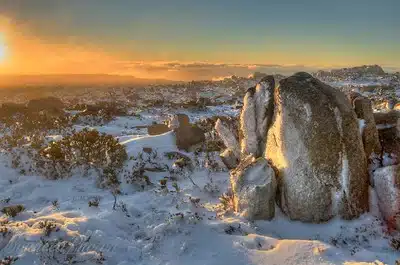Experience the Magic of Snow In Australia with Breathtaking Alpine Views and Top-Rated Ski Resorts
Experience the Magic of Snow In Australia with Breathtaking Alpine Views and Top-Rated Ski Resorts
Blog Article
Discover the Fascinating Results of Snow in Australia on Regional Ecological Communities
Regardless of its track record for sun-soaked landscapes, Australia also flaunts areas buried by snow-- a sensation that profoundly affects the country's unique ecological communities. The shielding residential properties of snows secure flora and fauna amidst the coldest winters, while the melting snow supports rivers and aquatic life.
The Unanticipated Regions of Snowfall in Australia
The high nation regions of New South Wales, Victoria, and Tasmania are especially known for their winter snow. The Snowy Hills in NSW, for instance, get bountiful seasonal snow, providing a stark contrast to the country's regular hot, arid environment. The existence of snow in these areas substantially influences neighborhood environments, consequently impacting the nation's special biodiversity.

Just How Snow Impacts Australia's Unique Vegetation
While it may seem uncommon, snowfall in Australia plays a crucial function in shaping the nation's special vegetation. The snow-filled winter seasons foster durability in Australian plant varieties. This is especially obvious in the alpine and sub-alpine regions, where snow periodontals and hill plum-pines prosper. These plants have actually developed to endure in extreme conditions, with snow offering as a protective covering from extreme winds and freezing temperatures. The snow also adds to the dampness material of the dirt, offering essential hydration for plant life during the dry summertime. Essentially, the snow influences the timing of blooming and seed dispersal, the growth rates, and the survival of lots of plant species, showcasing the elaborate interplay in between climate and flora in Australia.

The Adjustments of Australian Animal to Snowfall
Simply as Australia's flora has adapted to the wintery conditions, the regional animals too, exhibit amazing adjustments to the snowfall. Species like the Hill Pygmy-possum, the only Australian marsupial recognized to hibernate, have progressed methods to make it through in snowy environments. It makes use of the snow as insulation, hibernating in rock crevices below the snow to remain warm. In a similar way, the Snow Skink, a species of reptile, alters its colour to white during wintertime, offering camouflage against predators. Birds such as the Snowy Mountains' Crimson Rosella likewise adjust their diets to consume available food sources during chillier periods. Thus, in spite of the extreme problems, Australian fauna demonstrates a flexible and durable nature, ensuring their survival in regions experiencing snowfall.
The Duty of Snow fit Neighborhood Ecological Communities
In forming the regional communities, the function of snow in Australia is both multilayered and profound. check that It influences the circulation of plants and animals, mostly specifying the biodiversity of alpine and sub-alpine areas. Snow gives an important water resource, feeding rivers and storage tanks as it thaws, thus sustaining a range of marine life forms. Furthermore, snow works as an insulator, protecting ground-dwelling organisms from severe cold. Similarly, it plays a substantial duty in dirt formation and nutrient biking. The regular cold and thawing of soil caused by snowfall fosters the failure of rocks, improving dirt fertility. Subsequently, the presence of snow forms the vegetation patterns, animal behavior, and general sustainability of Australia's distinct ecological communities. Does Australia Get Snow.

The Future of Snowfall in Australia: Ramifications and forecasts

Offered the essential duty snow plays fit regional ecological communities, the future of snowfall in Australia is attracting enhancing focus from environmentalists and scientists. Current climate versions anticipate a considerable decline in snowfall because of worldwide warming, with possibly profound influences on neighborhood communities. Less snow can cause decreased water availability in alpine regions, negatively influencing wildlife environments and plant life. In addition, it can change the timing of seasonal changes, interfering with the life process of many native species. The tourism market, heavily reliant on the winter snow season, might likewise encounter significant challenges. Understanding these predictions and their ramifications is vital to establish reliable preservation methods, making sure the preservation of Australia's one-of-a-kind biodiversity and the sustainability of its economic situation.
Final Thought
The function of snow in Australia's communities is critical yet typically overlooked. It serves as a protector, a directory nurturer, and a shaper of varied alpine varieties, adding to the splendor of Australia's high nation. As weather patterns continue to move, comprehending the implications and potential changes of these snow-influenced environments is crucial. Hence, the snow in Australia is more than an all-natural phenomenon; it's an essential gamer in the nation's environmental narrative.
Regardless of its reputation for sun-soaked landscapes, Australia likewise flaunts regions blanketed by snow-- a phenomenon that greatly affects the country's one-of-a-kind communities. It uses the snow as insulation, hibernating in rock crevices beneath the snow to remain warm - Does It Snow In Australia.In shaping click for more info the neighborhood ecological communities, the function of snow in Australia is both multilayered and extensive. The presence of snow shapes the vegetation patterns, animal habits, and general sustainability of Australia's one-of-a-kind ecosystems
Given the essential duty snow plays in forming local ecological communities, the future of snowfall in Australia is attracting raising interest from conservationists and scientists.
Report this page